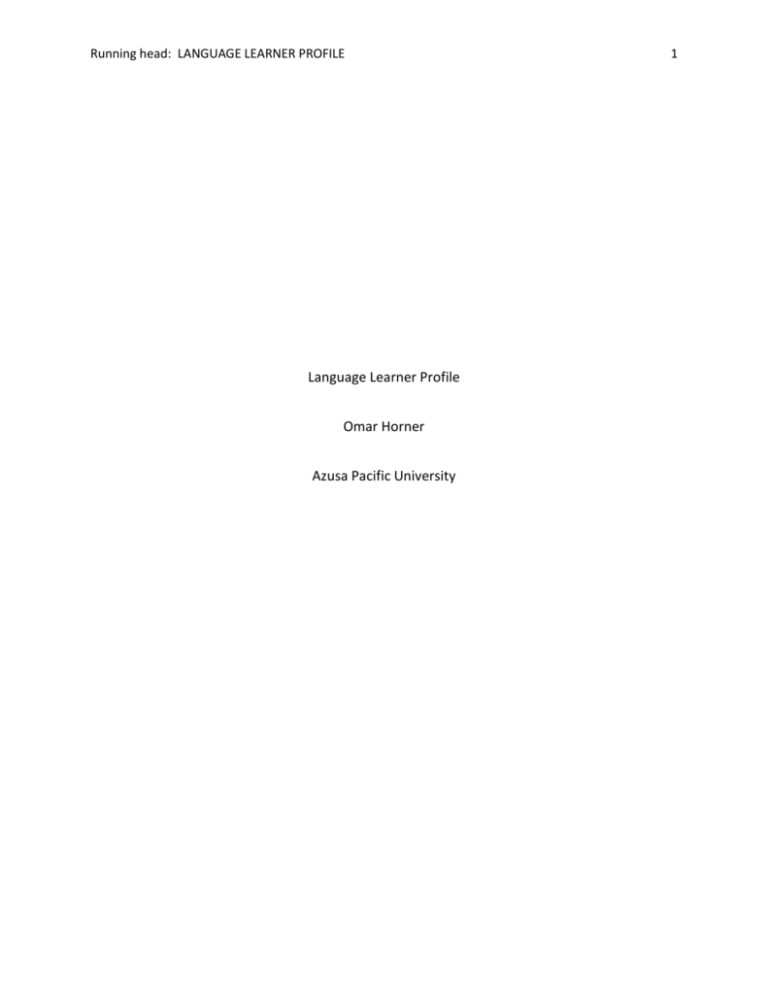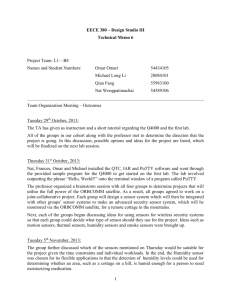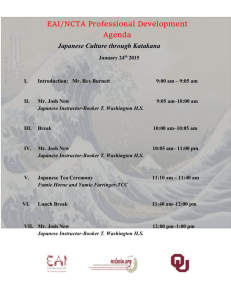
Running head: LANGUAGE LEARNER PROFILE
Language Learner Profile
Omar Horner
Azusa Pacific University
1
LANGUAGE LEARNER PROFILE
2
Language Learner Profile: Omar Horner
Omar is an American English teacher who is currently working in Japan. He will reside
there for two years, and has decided that it is important for him to become competent in
Japanese to fully understand the process of acquiring another language. He believes that this
will help him to meet the needs of his students and become a better language teacher. Omar is
33 years old and has been teaching English for 4 years in Korea and 6 months in Japan.
Additionally, he has decided to analyze the process and the way he learns the Japanese
language to benefit his second language acquisition.
Personality and Background Factors
First of all, it should be understood that there are many characteristics that make
Omar’s language acquisition experience unique. Though many share similar characteristics, no
two learners are identical (Brown, 2007, p. 69). Before analyzing in depth, it is important to
consider his history in acquiring a second language and his individual learning preferences.
Omar studied two languages while attending public school in his youth. The first was
Spanish. Most of his Spanish classes were conducted by nonnative teachers and focused mainly
on grammatical translation and on contrastive analysis. His goal was to pass the tests and
acquire a grade. His experience studying Spanish was unfavorable, and, when he had to take
more language classes, he decided to try Latin. His experience in Latin was similar. In both of
these cases, Omar attributed the classroom management for his inability to acquire the target
language.
LANGUAGE LEARNER PROFILE
3
It is important to understand that Omar’s experiences have made him skeptical of the
classroom environment. This has led him to take a novel approach to learning a language
outside the classroom. He believes that he will have more success by studying grammar and
vocabulary during his free time and testing his ability and knowledge by communicating with
the target language community afterwards. As noted by Lightbown and Spada (2006), learners
living in the target language community, such as Omar, prefer to “separate grammar from
communicative interaction.” Omar seems to adhere to this principle as he prefers learning
grammar and vocabulary separate from his communicative practice. Additionally, Lightbown
and Spada (2006) claim that there is often a “mismatch between students’ and teacher’s views”
when it comes to language learning. Omar’s previous attempts to learn a language have been
unsuccessful; therefore, he is endeavoring to learn the language outside of a formal teaching
arrangement.
This idea of studying alone and communicating openly afterwards may also reflect his
personality type. Omar considers himself introverted as he prefers to study and work alone.
However, due to his inability to acquire Spanish and Latin, he has come to the conclusion that it
is important for him to become more extroverted in his approach. This has led him to develop
into a communicative risk-taker. Though this would not be his natural approach to learning a
language, he believes that it will be the most effective. Brown (2007) writes that
“compensatory techniques” could be used to overcome certain perceived “learning style
weaknesses” (p. 271). In this case, Omar had identified his personality to be a weakness in his
language learning and has sought to correct it.
LANGUAGE LEARNER PROFILE
4
When considering Omar’s learning preferences, it is beneficial to note that he prefers a
visual style of learning, as opposed to an auditory or kinesthetic style. This is another reason
for his choice to study without the aid of a teacher. Omar believes that he is capable of
learning more vocabulary by reading and memorizing lists than by hearing a teacher or
interacting in group work. As an introvert, he does not like group work, and he is aware that it
would be encouraged in the language classroom.
In conclusion, Omar’s previous attempts at learning a language have highly impacted his
approach to language learning in the present. Most notably, it has affected his decision to learn
Japanese outside of a classroom without formal instruction. It has also motivated him to
change certain personal characteristics that he perceives to be a weakness in his language
acquisition.
Cognitive Factors
The next consideration is the cognitive factors that impact Omar’s language acquisition.
Scovel (2001) points out that “the human brain is by far the most complicated computer in the
animal kingdom” and, in short, “cognition explains everything” (p. 91). Understanding Omar’s
cognitive processes will reveal insight into his language learning.
It should be remembered that Omar has attempted to compensate for some of his
perceived deficiencies in acquisition. Previously, his preference was to be field independent,
learning in a classroom setting. In many ways he has tried to integrate this cognitive practice
with his new understanding of language learning by studying on his own and memorizing
vocabulary. However, he has tried to become more field dependent with his strategies,
LANGUAGE LEARNER PROFILE
5
learning through social interaction. However, as his natural preference is to be field
independent, often he views his social interactions, or his field dependent actions, only as
practice and tests of his learning.
Additionally, Omar tends to be more analytical instead of holistic as he prefers rules and
accuracy over learning in chunks, or groups of words. He is more of a serial learner verses a
random learner in that he prefers to study from books and lists. He has difficulty learning
through unplanned events and random encounter. By nature, he is more reflective than
impulsive, preferring time to plan and organized his thoughts before speaking. However, he
has attempted to compensate in this practice as he wants to be more impulsive. He takes an
active approach in his cognitive style as he does not want to learn in a classroom or with formal
guidance, as a passive learner might prefer.
Recognizing certain problems with his usual cognitive approach, Omar seeks to become
more holistic, random, and impulsive. However, he has still avoided formal instruction and
continues to disregard structured teaching.
Affective Factors
Many researchers have speculated about the effect of emotions upon language
acquisition. For instance, Krashen (1985) theorized about an “affective filter” and its
involvement in second language acquisition. Krashen claimed that, as children, we have not yet
constructed a social identity, and are, therefore, less worried about how we are evaluated.
Adults, on the other hand, have created a “filter” based on a social identity that involves
“motivation, self-esteem, and anxiety.”
LANGUAGE LEARNER PROFILE
6
There is a concept about a “language ego” that can best describe Omar’s self-esteem
involving Japanese. The “language ego” theory is the concept that a second personality is
created when learning a new language. This second personality is very fragile and weak as it
has not yet fully acquired the language. Brown (2007) claims, “highly intelligent adults can be
reduced to babbling infants in a second language” (p. 72). According to this theory, too much
criticism will hinder the learning process. Omar has faced criticism to a certain degree, and this
has caused him to stop practicing the language with certain Japanese speakers. Additionally,
one of the reasons he does not want to have a teacher is because he does not want to face
criticism. Particularly, he does not want to receive criticism about his accent or pronunciation.
However, it is still early in his development, and he has been willing to take risks. Perhaps, with
time, his self-esteem and his language ego will become stronger. For the time being, it is
important that he does not receive too much criticism and he is able to develop more fluency
and the self-esteem of his language ego is allowed to develop.
Anxiety does not seem to have much of an impact on Omar. For instance, he does not
feel anxious about learning or speaking Japanese, but is rather relaxed as he does not have any
tests or particular goals to consider. His study is very casual. In fact, if anything, Omar needs to
experience more facilitative anxiety to increase the speed of his language acquisition. It would
be helpful for Omar to set more goals and place himself in situations where he must interact
outside of his boundaries. For instance, he could place certain goals involving verb conjugations
and vocabulary development.
LANGUAGE LEARNER PROFILE
Finally, there is Omar’s motivation for learning Japanese. According to Scovel (2001),
“Of all the affective factors discussed over the years by both teachers and SLA researchers, by
far the most predominant is the complex interplay of variables subsumed under the term
motivation” (p. 121). For Omar, motivation for learning Japanese has proven to be integral. In
his past language learning experiences, it seems that motivation was highly lacking. Omar will
only be in Japan for two years, and he feels that once he leaves Japan, he will not have many
opportunities to use Japanese. Additionally, he believes that his first language, English, will be
far more useful for travel and communication across continents. However, in this situation,
Omar is highly motivated to learn Japanese. This is for professional purposes. As mentioned
earlier, it will increase his validity as a language instructor if he has indeed acquired a second
language. Considering this, his motivation would be instrumental as opposed to integrative.
He wants to obtain the language for professional reasons, not for communicative purposes in
the target language community. Also, his motivation is more intrinsic as opposed to extrinsic.
There are no outside factors forcing him to learn the language. He is learning Japanese for
personal reasons. However, there is slight extrinsic pressure from co-teachers and
management to learn the language. Also, it is necessary for him to pass a language test to
receive his MA TESOL. Presently though, he seems to feel little pressure and is mostly learning
the language on his own accord. Omar’s lack of facilitative anxiety is most likely due to the
absence of extrinsic motivation.
In many ways, motivation is described as an ongoing and changing process. It can be
placed into three sequential progressions: choice, executive, and retrospective (Dörnyei, 2001).
Choice motivation involves beginning a certain task. As Omar is not under any pressure, he
7
LANGUAGE LEARNER PROFILE
8
initiates different processes of study, such as vocabulary or verb conjugation, rather slowly.
However, his executive motivation, or his ability to complete the task, is high. In other words,
Omar is slow to take on particular tasks, but his ability to accomplish them is elevated. Finally,
his retrospective motivation seems to fluctuate based on the success of his task. For instance,
Omar has been very diligent memorizing vocabulary lists, but has slowed in the area of verb
conjugation. This can best be explained by his success in the particular task.
Though Omar prefers deep thought and memorization in his study of Japanese, it is
evident that many affective factors influence his study. This must be considered when giving
feedback or criticism, especially since he is reaching outside of his normal learning styles and
preferences to obtain the language.
Linguistic Factors
It should be clear that Omar has taken a very methodical and contemplative approach
to learning Japanese. As a naturally field independent learner, he usually likes to break apart
language and understand the meaning of each individual word. As this is his preferred
approach, he does not have a high tolerance for ambiguity. When he receives input that is too
complex, he tends to ignore it rather than attempt to process or retain it. This has resulted in a
number of errors.
One particular error related to his one-to-one approach, was an induced error that was
learned from an interlocutor. The error resulted in an overgeneralization that, in some ways,
has become fossilized (Scovel, 2001, p. 52). Omar asked a Japanese speaker to translate the
English verb has into Japanese. He was given the word motsu, which literally means “to hold.”
LANGUAGE LEARNER PROFILE
9
In English, the word has can be very idiomatic and it contains multiple meanings. For instance,
“The boy has a pencil,” presents a much different meaning than “The boy has a cold.” Omar
has used the word motsu in all cases of English language transfer to interlanguage, even after
he was made aware of his mistake. He claims that this is due to the fact that Japanese people
can still understand him when he used this verb inappropriately.
Another form of interference in his language acquisition can best be described as
avoidance (Scovel, 2001, p. 57). Omar has a difficult time conjugating Japanese verbs as they
are very different from English forms. To learn the conjugations, he has attempted to
memorize certain common conjugations. One very common Japanese verb is shimasu, which
means to “do.” Omar learned that shimasu can be connected to nouns or adjectives to
describe an action. Instead of attempting to form an unknown conjugation of a word, such as
clean, Omar might utilize the known conjugation of shimasu. For instance, instead of saying in
Japanese, “The boy cleaned the floor,” Omar would say, “The boy did pretty the floor.” He
would utilize an adjective and the shimasu verb to avoid conjugating the Japanese verb for
clean.
Japanese and English are very different languages. Because of Omar’s cognitive style
and learning preferences, his Japanese language acquisition has experienced a great deal of
interference from his first language, English. Brown (2007) says, “The majority of learner’s
errors in producing the second language, especially in the beginning levels, stem from the
learner’s assumption that the target language operates like the native language” (p. 76). This is
LANGUAGE LEARNER PROFILE
10
clearly seen in Omar’s overgeneralizations and in the errors caused by his one-to-one
translation style of learning.
Conclusion
There are many factors that influence Omar’s Japanese language acquisition. Most
notably, his insistence on avoiding a classroom and formal teaching instruction is slowing his
language acquisition. Because of his persistence on self-study, he is experiencing very little
facilitative anxiety. He would benefit from more extrinsic motivation and outside pressure. He
has noted and changed certain personal characteristics that may limit the language process,
such as being willing to communicate and risk-taking; however, he could improve by increasing
his tolerance for ambiguity and taking a holistic approach to learning.
The Attribution Theory states that learners will attribute success to internal factors and
they will attribute failure to external factors. In Omar’s case, he seems to have completely
ascribed previous failures in language acquisition to teacher’s classroom practices, and, as a
result, has sought to learn completely on his own accord. Though he has been willing to try
different approaches to language learning, his acquisition would be enhanced by formal
teaching from a Japanese teacher. It is important for Omar to recognize the affective factors
that are influencing his decision. Real learning will take place when he begins to utilize outside
assistance.
LANGUAGE LEARNER PROFILE
References
Brown, H. D. (2007). Teaching by Principles: An Interactive Approach to Language
Pedagogy. White Plains NY: Pearson Longman.
Dörnyei, Z. (2001). Motivational Strategies in the Language Classroom. Cambridge, UK;
Cambridge University Press.
Krashen, S. (1985). The Input Hypothesis. London: Longman.
Lightbown, P. M., & Spada, N. (2006). How languages are learned (3rd ed.). Oxford: Oxford
University Press.
Scovel, T. (2001). Learning New Languages; a guide to second language acquisition. Boston:
Heinle Cengage Learning
11










